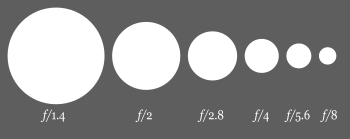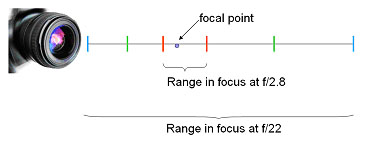Understanding exposure basics is crucial to making a great photograph. What is aperture? Invest some time to understand all the ingredients of exposure. Make sure you read the introduction to exposure first. Here we discuss aperture, and its effect on both exposure and depth of field.
Aperture Definition
The aperture is the opening in the lens that allows light through. Controlling how wide the opening is controls the amount of light that hits the sensor (or film). Just like with the other two ingredients of exposure, ISO and shutter speed, aperture is measured in increments of stops. In this case, we refer to them as f-stops.
Once again, a stop up or down will double or halve the amount of light hitting the film or sensor. Each aperture f-stop lets through half the light of the previous one. The standard f-stops are:
f/2.8, f/4, f/5.6, f/8. f/11, f16, f22

Illustration of the standard f-stops
Image source: http://wikipedia.org
To get the same exposure using an aperture of f/5.6 or f/8, we would have to compensate by varying one of the other ingredients of exposure: ISO or shutter speed. For example, if we open the aperture half as wide, we’d have to leave the shutter open twice as long to get an equivalent exposure.
How do you choose the right aperture?
Aperture affects more than just exposure. It also affects how much of the image is in focus. We call this depth of field.
Exposure Basics: What is Depth of Field (DOF)?
Depth of field refers to how much of the image is in focus. When you lock focus on a particular subject, there will be some amount of material both in front of and behind it that is also sharp and in focus. After that, focus will drop off, and things that are further away from your focal point will appear "soft" and out of focus.
Large apertures (e.g., f2.8) result in very little of the image on either side of the focal point being in focus. Small apertures (e.g., f/22) result in a lot of the image on either side of the focal point also being in focus.
1/3 of the range of in-focus material falls in front of the point on which you focus your camera, and 2/3 falls behind it. Assuming that the closest point in the image is at the bottom, and the furthest point is at the top, this means that to achieve the greatest amount in focus, you should focus at a point 1/3 of the way up the picture space.

The range in focus spans 1/3 in front of the focal point
and 2/3 behind.
(Image is not to scale)
© Julie Waterhouse Photography
Tip
Be careful when using a DOF in the mid range. It has it’s use, however sometimes, when only part of the image is in focus, it can look accidental, like you "missed" getting the focus right. This is especially true for close-up photography, where I always recommend committing to a point of view: soft focus, or detail, but not in-between.
A shallow depth of field means very little is in focus. This is called selective focus. Using this technique draws attention to the part of the picture that is in focus. It can also be used to minimize a distracting background; i.e., if the background is blurred through shallow depth of field, it draws less attention.
Use a small f-stop value, like f/2.8, which corresponds to a wide aperture opening, to achieve shallow depth of field. A small f-stop number means a small amount in focus.
A large depth of field, where you have a lot in focus, is useful if you want to show a lot of detail.
Use a large f-stop value, like f/22, which corresponds to a small aperture opening, to achieve large depth of field. A large f-stop number means a large amount in focus.
 Lots of detail, with a deep depth of field. Taken with an aperture of f/22. © Julie Waterhouse Photography |
 Soft image, with shallow depth of field. Taken with an aperture of f/2. © Julie Waterhouse Photography |
Exposure Basics: Putting it all together
For an equivalent total exposure, a fast shutter speed requires a larger aperture (i.e., a smaller f-stop number), whereas a slow shutter speed requires a smaller aperture (larger f-stop number).
Exposure Basics: Exercise
Assume that each of the following should be an equivalent exposure. If you vary one of the three ingredients (ISO, shutter speed or aperture), you must vary another one to compensate. Test your understanding, and fill in the missing numbers.
ISO 200, f/8, 1/60s
ISO 400, f/8, 1/125s
ISO 200, f/11, 1/30s
ISO 400, f/5.6, 1/250s
ISO 100, f/8, 1/?s
ISO ?, f/8, 1/125s
ISO 200, f/?, 1/125s
Don’t peek below until you try it yourself!
Answers: 1/30s, ISO 400, f/5.6
I hope that’s given you a good aperture definition to answer the question "What is aperture?"
Next, review ISO or shutter speed.
Next, you may be interested in learning about composition.